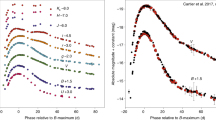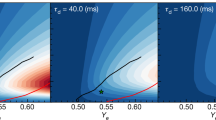Abstract
THAT type II supernovae apparently occur predominantly in stars significantly more massive than the Sun has been known1 for some time, although a precise stellar mass range for these cataclysmic events can not be defined observationally. Recent theoretical interpretations2–4 of diverse observational data seem, however, to indicate independently that the masses are significantly in excess of 8M⊙. Furthermore, observational evidence5 may exist that stars with masses below 6M⊙ cease nuclear burning before a critical supernova configuration evolves. If this is the case, the total supernovae contribution from the stars of lower mass is negligible and theoretical difficulties6 associated with such events are resolved. The circumstantial evidence for massive (>8M⊙)supernova progenitors is thus reinforced, although problems arise in understanding the supernova mechanism.
This is a preview of subscription content, access via your institution
Access options
Subscribe to this journal
Receive 51 print issues and online access
$199.00 per year
only $3.90 per issue
Buy this article
- Purchase on Springer Link
- Instant access to full article PDF
Prices may be subject to local taxes which are calculated during checkout
Similar content being viewed by others
References
Shklovsky, I. S., Supernovae (Wiley, New York, 1968).
Moore, E., Publ. Astr. Soc. Pacific, 85, 564 (1973).
Dallaporta, N., Astr. Astrophys., 29, 393 (1973).
Arnett, W. D., and Schramm, D. N., Astrophys. J. Lett., 184, L47 (1973).
Eggen, O. J., and Greenstein, J. L., Astrophys. J., 141, 83 (1965).
Buchler, J. R., Mazurek, T. J., and Truran, J. W., Comm. Astrophys. Space Phys. (in the press).
Hoyle, F., and Fowler, W. A., Astrophys. J., 132, 565 (1960).
Colgate, S. A., and White, R. H., Astrophys. J., 143, 626 (1966).
Wilson, J. R., Astrophys. J., 163, 209 (1971).
Colgate, S. A., Astrophys. J., 153, 335 (1968).
Arnett, W. D., Astrophys. J., 153, 341 (1968).
Freedman, D. Z., Phys. Rev., 9 D, 1389 (1974).
Wilson, J. R., Phys. Rev. Lett., 32, 849 (1974).
Bahcall, J. N., Phys. Rev., 136, B1164 (1964).
Imshennik, V. S., and Nadezhin, D. K., Sov. Phys. JETP, 36, 821 (1973).
Arnett, W. D., Can. J. Phys., 44, 2553 (1966).
Beaudet, G., Petrosian, V., and Salpeter, E. E., Astrophys. J., 150, 979 (1967).
Langer, W. D., Rosen, L. C., Cohen, J. M., and Cameron, A. G. W., Astrophys. Space Sci., 5, 259 (1969).
Author information
Authors and Affiliations
Rights and permissions
About this article
Cite this article
MAZUREK, T. Degeneracy effects on neutrino mass ejection in supernovae. Nature 252, 287–289 (1974). https://doi.org/10.1038/252287a0
Received:
Accepted:
Issue Date:
DOI: https://doi.org/10.1038/252287a0
Comments
By submitting a comment you agree to abide by our Terms and Community Guidelines. If you find something abusive or that does not comply with our terms or guidelines please flag it as inappropriate.



